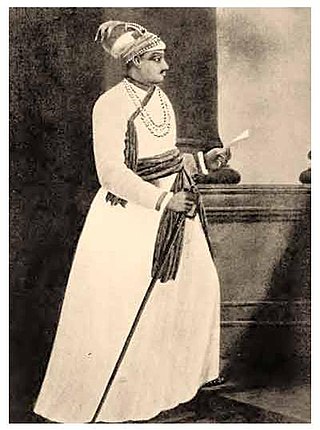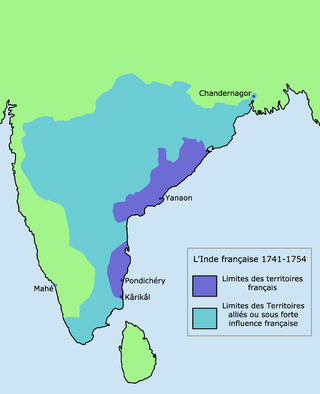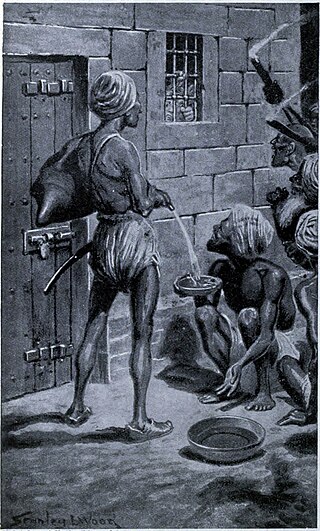
The Battle of Plassey was a decisive victory of the British East India Company, under the leadership of Robert Clive, over the Nawab of Bengal and his French allies on 23 June 1757. The victory was made possible by the defection of Mir Jafar, Nawab Siraj-ud-Daulah's commander in chief as well as much of the Bengal Subah's armies being earlier committed against an Afghan invasion led by Ahmad Shah Durrani against the Mughal Empire. The battle helped the British East India Company take control of Bengal in 1772. Over the next hundred years, they continued to expand their control over vast territories in the rest of the Indian subcontinent, including Burma.

Mir Syed Jafar Ali Khan Mirza Muhammad Siraj-ud-Daulah, commonly known as Siraj-ud-Daulah or Siraj ud-Daula, was the last independent Nawab of Bengal. The end of his reign marked the start of the rule of the East India Company over Bengal and later almost all of the Indian subcontinent.

Murshidabad is a historical city in the Indian state of West Bengal. It is located on the eastern bank of the Bhagirathi River, a distributary of the Ganges. It forms part of the Murshidabad district.
Kolkata was a colonial city. The British East India Company developed Calcutta as a village by establishing an artificial riverine port in the 18th century CE. Kolkata was the capital of the British India until 1911, when the capital was relocated to Delhi. Kolkata grew rapidly in the 19th century to become the second most important city of the British Empire after London and was declared as the financial (commercial) capital of the British India. This was accompanied by the fall of a culture that fused Indian philosophies with European tradition.
The Treaty of Alinagar was signed on 9 February 1757 between Robert Clive of the British East India Company and the Nawab of Bengal, Mirza Muhammad Siraj ud-Daulah. Alinagar was the short-lived name given to Calcutta given by the Nawab after it was captured by him. The Nawab had seized the English fort at Calcutta, but facing the threat of Afghans in the rear and the military might of the English, he signed the treaty.

The Nawab of Bengal was the hereditary ruler of Bengal Subah in Mughal India. In the early 18th-century, the Nawab of Bengal was the de facto independent ruler of the three regions of Bengal, Bihar and Orissa which constitute the modern-day sovereign country of Bangladesh and the Indian states of West Bengal, Bihar and Odisha. The Bengal Subah reached its peak during the reign of Nawab Shuja-ud-Din Muhammad Khan. They are often referred to as the Nawab of Bengal, Bihar and Orissa. The Nawabs were based in Murshidabad which was centrally located within Bengal, Bihar, and Odisha. Their chief, a former prime minister, became the first Nawab. The Nawabs continued to issue coins in the name of the Mughal Emperor, but for all practical purposes, the Nawabs governed as independent monarchs. Bengal continued to contribute the largest share of funds to the imperial treasury in Delhi. The Nawabs, backed by bankers such as the Jagat Seth, became the financial backbone of the Mughal court.

Mir Jafar, was a commander-in-chief or military general who reigned as the first dependent Nawab of Bengal of the British East India Company. His reign has been considered by many historians as the start of the expansion of British control of the Indian subcontinent in Indian history and a key step in the eventual British domination of vast areas of pre-partition India. He is best known for his betrayal of Nawab Siraj-ud-daulah in the Battle of Plassey.

William Watts was a British official with the East India Company. He was involved in the overthrow of the last independent ruler of Bengal, leading directly to the consolidation of Company rule in Bengal and his own personal enrichment. Through his wife Begum Johnson, he had notable descendants, including a Prime Minister of the United Kingdom.

Kalikata was one of the three villages which were merged to form the city of Kolkata in India. The other two villages were Gobindapur and Sutanuti. Job Charnock, an administrator with the British East India Company is traditionally credited with the honour of founding the city. He settled in the village of Sutanuti.

Alivardi Khan was the fourth Nawab of Bengal from 1740 to 1756. He toppled the Nasiri dynasty of Nawabs by defeating Sarfaraz Khan in 1740 and assumed power himself.

The siege of Calcutta was a battle between the Bengal Subah and the British East India Company on 20 June 1756. The Nawab of Bengal, Siraj ud-Daulah, aimed to seize Calcutta to punish the company for the unauthorised construction of fortifications at Fort William. Siraj ud-Daulah caught the Company unprepared and won a decisive victory.
Roger Drake was a British administrator in the East India Company. He served as President of Fort William in Bengal between 1752 and 1756 and was later reprimanded for his actions during the Siege of Calcutta in 1756.

The Black Hole of Calcutta was a dungeon in Fort William, Calcutta, measuring 14 by 18 feet, in which troops of Siraj-ud-Daulah, the Nawab of Bengal, held British prisoners of war on the night of 20 June 1756. John Zephaniah Holwell, one of the British prisoners and an employee of the East India Company, said that, after the fall of Fort William, the surviving British soldiers, Indian sepoys, and Indian civilians were imprisoned overnight in conditions so cramped that many people died from suffocation and heat exhaustion, and that 123 of 146 prisoners of war imprisoned there died.

The Bengal Subah, also referred to as Mughal Bengal and Bengal State, was the largest subdivision of Mughal India encompassing much of the Bengal region, which includes modern-day Bangladesh, the Indian state of West Bengal, and some parts of the present-day Indian states of Bihar, Jharkhand and Odisha between the 16th and 18th centuries. The state was established following the dissolution of the Bengal Sultanate, a major trading nation in the world, when the region was absorbed into the Mughal Empire. Bengal was the wealthiest region in the Indian subcontinent.

Khushbagh is the garden-cemetery of the Nawabs of Bengal, situated on the west bank of the Hooghly river, about a mile from its east bank, in the Murshidabad-Jiaganj CD block in Lalbag subdivision of Murshidabad district, West Bengal, India. Khushbagh hosts the graves of the Nawabs of Bengal of the Afshar dynasty and their family members; while Jafarganj Cemetery hosts the graves of the later Nawabs and their families, starting from Mir Jafar, who belonged to the Najafi dynasty. Khushbagh is the resting place of Nawab Siraj ud-Daulah, his wife Lutf-un-nisa, Nawab Alivardi Khan, and his mother, amongst others.
Zinzira Palace, also spelt Jinjira Palace, is a late 17th century Mughal-era palace in Keraniganj, Bangladesh on the southern banks of the Old Ganges or Buriganga River. It was built by Ibrahim Khan II, Bengal's last subedar before Aurangzeb's grandson Azim-ush-Shan took control of the region, as his recreation resort opposing the Bara Katra in the Chowk Bazar neighborhood of Old Dhaka on the other side of the river. The palace is known for the tragic imprisonment of the female members of the Bengal Nawab family following the Battle of Plassey (1757).

Lutfunnisa Begum was the 3rd wife and primary consort of Siraj ud-Daulah, the last independent Nawab of Bengal.

Amina Begum was a Bengali aristocrat from the Nawab family of Bengal and mother of Siraj ud-Daulah, the last independent Nawab of Bengal.

Jagat Seth was a wealthy merchant, banker and money lender family from Murshidabad in Bengal during the time of the Nawabs of Bengal.
Khoja Wajid was a wealthy Armenian merchant who played a prominent role in the economic and political life of Bengal in the 1740s and 50s.













